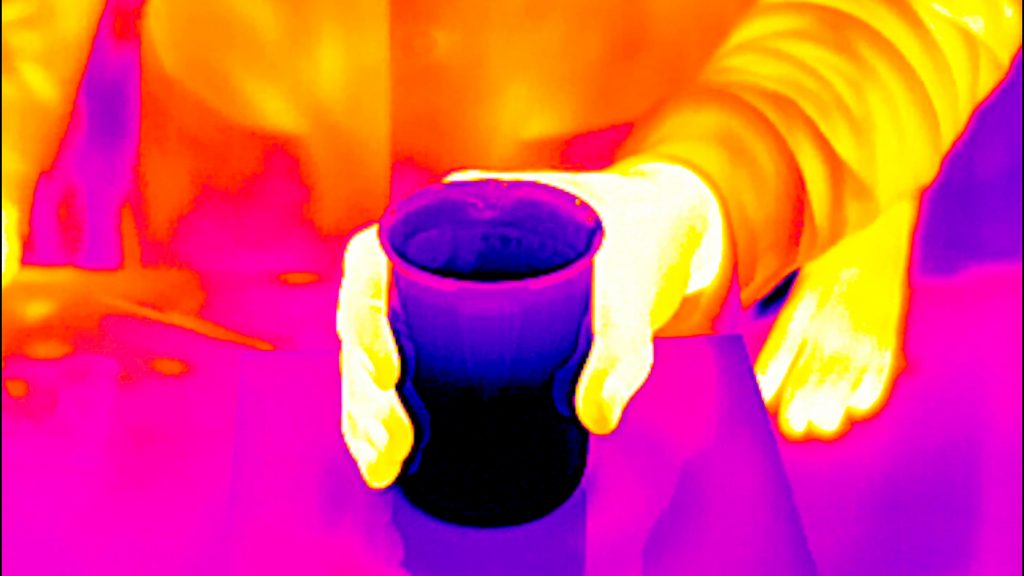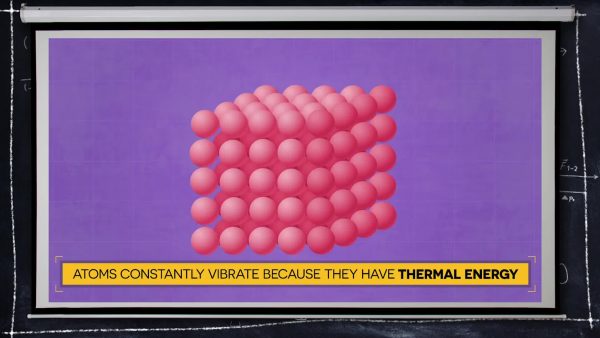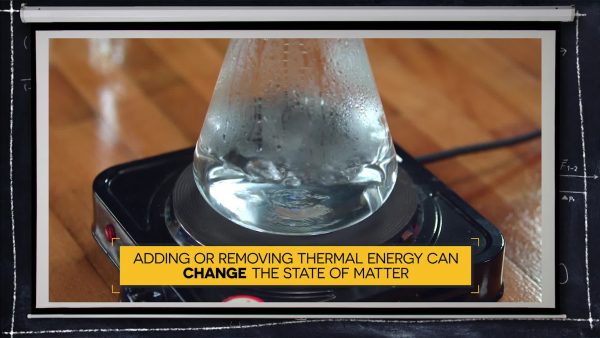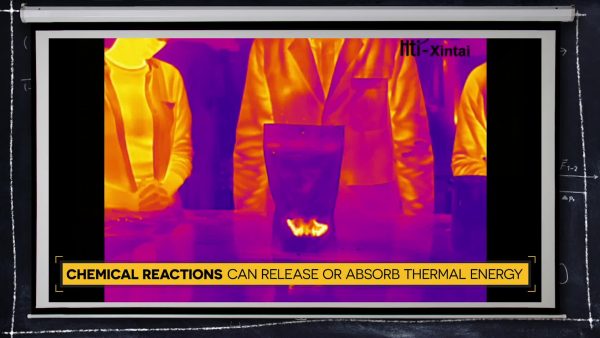
The atoms or molecules that make up substances are always vibrating as a result of thermal energy. When a substance is hotter, that means its atoms or molecules are vibrating faster. Thermal energy always moves from a hotter area to a colder area. Adding or removing thermal energy can cause a substance to change from one state to another, and chemical reactions can cause thermal energy to increase or decrease.
To better understand thermal energy…
LET’S BREAK IT DOWN!
What is thermal energy?

All matter is made up of particles, either atoms or molecules, and these particles are constantly vibrating. The energy of these moving particles is called thermal energy and is related to the temperature of the substance. Temperature measures the average kinetic (or motion) energy of the particles within a substance. Temperature measures an average because the particles within a substance do not all move at exactly the same speed. The particles in hotter substances are moving faster, whereas the particles in colder substances are moving slower.
Changing States of Matter

Thermal energy and temperature help us explain how matter changes from one state to another. Think about water as an example. The molecules in ice (solid water) are packed tightly together and just vibrating in place. The temperature of ice is low, 0°C or lower. The molecules in liquid water vibrate more and are constantly bumping into and sliding past each other. The temperature of liquid water is higher than ice, between 0°C and 100°C. The molecules in water vapor, a gas, move so fast that they spread far about. The temperature of water vapor, which is also called steam, is higher than liquid water, 100°C or higher. Matter can change state when thermal energy is transferred into or out of the substance. Ice melts and liquid water boils as thermal energy is added. Water vapor condenses and liquid water freezes as thermal energy is removed. Thermal energy always moves from a hotter area to a colder area, and this movement of thermal energy is called heat.
Reducing Thermal Energy Transfer

Transferring thermal energy can be very useful when we want to heat something up or cool something down. But sometimes we want to keep hot things hot or cold things cold. In these cases, we want to reduce the amount of thermal energy that is transferred into or out of a substance. We can do this by surrounding the substance, such as hot coffee, with another material called an insulator that does not transfer thermal energy very well. These materials, such as cardboard or foam, often have lots of air space. Because the air molecules in that space are not close together, they do not transfer thermal energy well. Thermoses use a vacuum (a space that contains no air molecules) to insulate hot liquids. With no molecules to bump into each other, thermal energy is transferred very slowly across the vacuum.
Chemical Reactions That Cause Thermal Energy Changes

Chemical reactions can cause changes in thermal energy by absorbing or releasing thermal energy. Reactions that release thermal energy heat up their surroundings by causing particles to vibrate faster. These reactions can be used to heat food or your hands and feet on a cold day. A fire is a great example of a chemical reaction that releases thermal energy, along with light energy. Reactions that absorb thermal energy cool down their surroundings by causing particles to vibrate slower. This kind of reaction is used in instant cold packs that you might put on a sports injury.
Thermal Energy in Everyday Life

We can find many examples of using thermal energy in our everyday lives. Any time you heat up or cool down something, you are using thermal energy. Heating and cooling foods provides some familiar examples. Baking chocolate chip cookies involves transferring thermal energy to the cookie dough, which causes the chocolate chips to change from a solid to a liquid. When the cookies cool, they transfer thermal energy to the air around them, and the chips return to a solid. Popcorn pops because the microwaves increase the thermal energy of the water molecules inside the kernels. The water turns to vapor, and the increasing pressure causes the kernels to explode. When you make ice pops, the freezer lowers the thermal energy of the liquid, turning it into ice. You can also see examples of thermal energy changes on a ski trip. Artificial snow is made by lowering the thermal energy of water droplets, and hand warmers use a chemical reaction that releases thermal energy to warm your hands.
INTRO TO THERMAL ENERGY VOCABULARY
INTRO TO THERMAL ENERGY DISCUSSION QUESTIONS
Why do hot objects have high temperatures?
What happens to the molecules that make up a chocolate chip as it is heated in the oven?
Why do water droplets form on the outside of a glass of cold soda?
Can frozen ice transfer thermal energy to another substance? If so, how?
How can you keep a cold drink cold without ice or a refrigerator?
How does an instant hand warmer make your hands feel warm?
Skip, I will use a 3 day free trial
Enjoy your free 30 days trial





